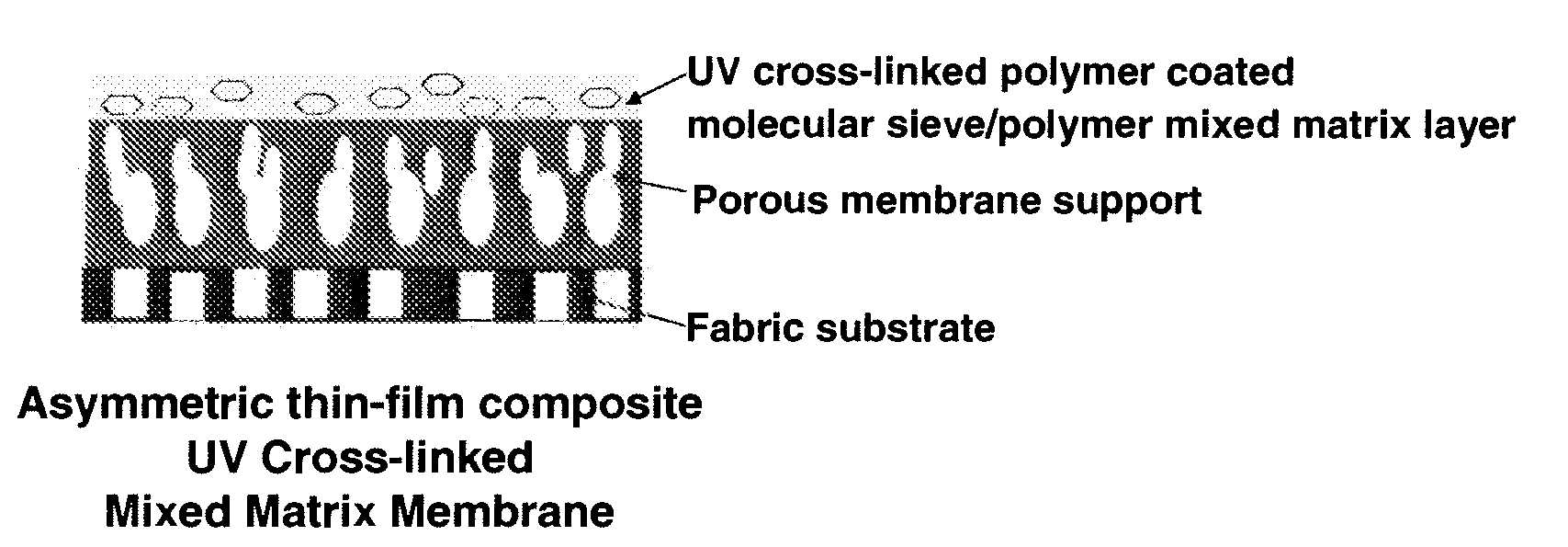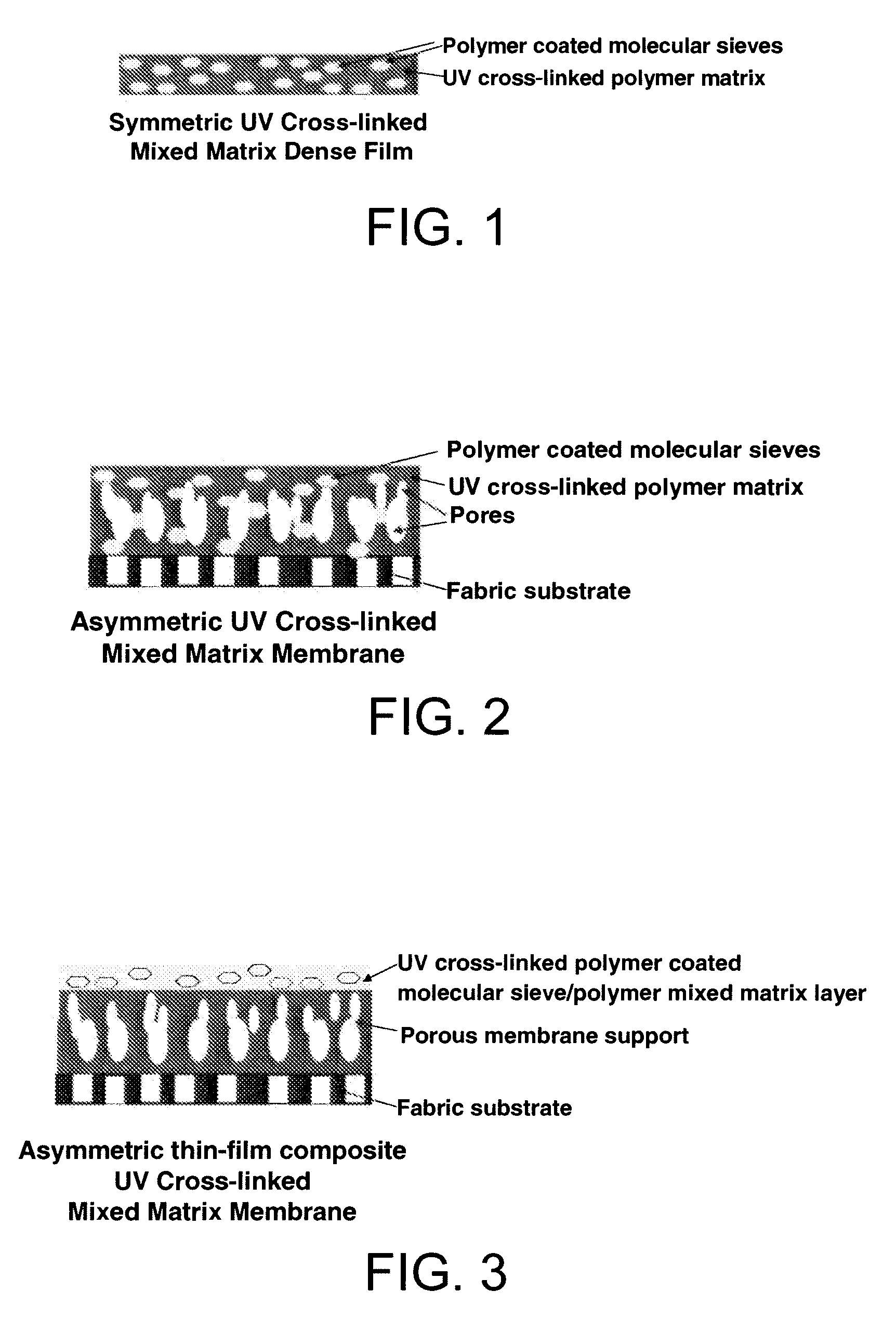UV cross-linked polymer functionalized molecular sieve/polymer mixed matrix membranes for sulfur reduction
a cross-linked polymer and functionalized molecular sieve technology, applied in the direction of membranes, separation processes, dispersed particle separation, etc., can solve the problems of increasing operating costs, reducing the efficiency of hydrotreating, and reducing the volume of feed, so as to reduce the volume of feed and improve the economics. , the effect of high sulfur conten
- Summary
- Abstract
- Description
- Claims
- Application Information
AI Technical Summary
Benefits of technology
Problems solved by technology
Method used
Image
Examples
example 1
Preparation of UV Cross-Linkable Poly(DSDA-PMDA-TMMDA)-PES Polymer Membrane (Abbreviated as P1)
[0089]5.4 g of poly(DSDA-PMDA-TMMDA) polyimide polymer (FIG. 9) and 0.6 g of polyethersulfone (PES) were dissolved in a certain amount of an organic solvent or a mixture of several organic solvents (e.g. a solvent mixture of NMP, acetone, and 1,3-dioxolane) by mechanical stirring to form a homogeneous casting dope. The resulting homogeneous casting dope was allowed to degas overnight. A poly(DSDA-PMDA-TMMDA) polymer membrane was prepared from the bubble free casting dope on a clean glass plate using a doctor knife with a 20-mil gap. The film together with the glass plate was then put into a vacuum oven. The solvents were removed by slowly increasing the vacuum and the temperature of the vacuum oven. Finally, the membrane was dried at 200° C. under vacuum for at least 48 h to completely remove the residual solvents to form P1 polymer membrane as described in Tables 1 and 2, and FIGS. 11 and...
example 2
Preparation of UV Cross-Linked Poly(DSDA-PMDA-TMMDA)-PES Polymer Membrane (Abbreviated as Control 1)
[0090]The Control 1 polymer membrane as described in Tables 1 and 2, and FIGS. 11 and 12 was prepared by further UV cross-linking P1 polymer membrane by exposure to UV radiation using 254 nm wavelength UV light generated from a UV lamp with 1.9 cm (0.75 inch) distance from the membrane surface to the UV lamp and a radiation time of 10 min at 50° C. The UV lamp described here is a low pressure, mercury arc immersion UV quartz 12 watt lamp with 12 watt power supply from Ace Glass Incorporated.
example 3
Preparation of UV Cross-Linked 30% AlPO-14 / PES / Poly(DSDA-PMDA-TMMDA) Mixed Matrix Membrane (Abbreviated as MMM 1)
[0091]UV cross-linked polyethersulfone (PES) functionalized AlPO-14 / poly(DSDA-PMDA-TMMDA) mixed matrix membrane (MMM 1) containing 30 wt-% of dispersed AlPO-14 molecular sieve fillers in UV cross-linked poly(DSDA-PMDA-TMMDA) polyimide continuous matrix (UV cross-linked 30% AlPO-14 / PES / poly(DSDA-PMDA-TMMDA)) was prepared as follows:
[0092]1.8 g of AlPO-14 molecular sieves were dispersed in a mixture of NMP and 1,3-dioxolane by mechanical stirring and ultrasonication for 1 h to form a slurry. Then 0.6 g of PES was added to functionalize AlPO-14 molecular sieves in the slurry. The slurry was stirred for at least 1 h to completely dissolve PES polymer and functionalize the surface of AlPO-14. After that, 5.6 g of poly(DSDA-PMDA-TMMDA) polyimide polymer was added to the slurry and the resulting mixture was stirred for another 2 h to form a stable casting dope containing 30 wt-%...
PUM
| Property | Measurement | Unit |
|---|---|---|
| particle sizes | aaaaa | aaaaa |
| size | aaaaa | aaaaa |
| median particle size | aaaaa | aaaaa |
Abstract
Description
Claims
Application Information
 Login to View More
Login to View More - R&D
- Intellectual Property
- Life Sciences
- Materials
- Tech Scout
- Unparalleled Data Quality
- Higher Quality Content
- 60% Fewer Hallucinations
Browse by: Latest US Patents, China's latest patents, Technical Efficacy Thesaurus, Application Domain, Technology Topic, Popular Technical Reports.
© 2025 PatSnap. All rights reserved.Legal|Privacy policy|Modern Slavery Act Transparency Statement|Sitemap|About US| Contact US: help@patsnap.com



